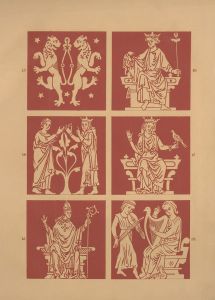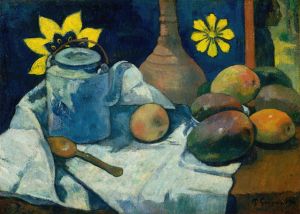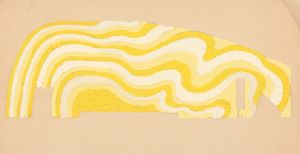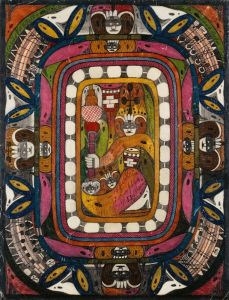
Design for miscellaneous interior.] [Sketch of interior
A hand-painted replica of Winold Reiss’s masterpiece Design for miscellaneous interior.] [Sketch of interior, meticulously crafted by professional artists to capture the true essence of the original. Each piece is created with museum-quality canvas and rare mineral pigments, carefully painted by experienced artists with delicate brushstrokes and rich, layered colors to perfectly recreate the texture of the original artwork. Unlike machine-printed reproductions, this hand-painted version brings the painting to life, infused with the artist’s emotions and skill in every stroke. Whether for personal collection or home decoration, it instantly elevates the artistic atmosphere of any space.
Winold Reiss was a German-American artist known for his work in portraiture and interior design, particularly during the early to mid-20th century. He was born in 1886 in Karlsruhe, Germany, and immigrated to the United States in 1913. Reiss's artistic style was heavily influenced by his European training, particularly in the Jugendstil and Art Nouveau movements, which emphasized decorative arts and the integration of art into everyday life.
Reiss's work in interior design often involved creating comprehensive artistic environments, where he would design not only the murals and paintings but also the furniture and other decorative elements. This holistic approach was part of a broader trend in the early 20th century that sought to unify art and design, making everyday spaces aesthetically pleasing and artistically coherent.
The piece titled "Design for miscellaneous interior. Sketch of interior" by Winold Reiss likely reflects his approach to interior design, where he would create detailed sketches to plan out the aesthetic and functional aspects of a space. Reiss was known for his vibrant use of color and pattern, often incorporating elements from various cultures into his designs. His work was characterized by a strong sense of composition and a keen eye for detail, which would have been evident in his interior sketches.
Reiss's career in the United States was marked by significant contributions to public and private spaces. He is perhaps best known for his work on the Cincinnati Union Terminal, where he designed a series of murals depicting the history of transportation. These murals are celebrated for their dynamic composition and vivid colors, showcasing Reiss's ability to blend artistic expression with architectural spaces.
In addition to his work in public spaces, Reiss also contributed to the design of restaurants, hotels, and other commercial interiors. His designs often featured bold geometric patterns and a mix of traditional and modern elements, reflecting the eclectic tastes of the time. Reiss's ability to adapt his style to suit different environments made him a sought-after designer during his career.
Reiss was also a prolific portrait artist, known for his empathetic and respectful portrayals of Native Americans and African Americans. His portraits were often commissioned for magazines and other publications, helping to bring greater visibility to underrepresented communities in the early 20th century.
While specific details about "Design for miscellaneous interior. Sketch of interior" are not widely documented, it can be inferred that this work would exemplify Reiss's skill in integrating art and design. His sketches would serve as a blueprint for creating spaces that were not only functional but also visually engaging, reflecting his belief in the transformative power of art in everyday life.
Overall, Winold Reiss's contributions to art and design were significant, and his work continues to be appreciated for its innovative approach and cultural sensitivity. His legacy is evident in the enduring appeal of his designs and the continued recognition of his role in shaping American art and interior design in the 20th century.









![Design for unidentified building ‘Small Dining Room’.] [Drawing of dining room with benches, in black, vermillion and white, bilaterally positive and negative coloring](/imgs/249298/s/winold-reiss-design-for-unidentified-building-small-dining-room-drawing-of-dining-room-with-benches-in-black-vermillion-and-white-bilaterally-positive-and-negative-coloring-31217372.jpg)
![Designs for unidentified restaurant interior, possibly Elysée restaurant, 1 East 56th St., New York, NY.] [Drawing of restaurant details](/imgs/249333/s/winold-reiss-designs-for-unidentified-restaurant-interior-possibly-elysee-restaurant-1-east-56th-st-new-york-ny-drawing-of-restaurant-details-5319cbfe.jpg)
![Drawings for proposed decorations of Mike Lyman’s Restaurant, 424 W. Sixth St., Los Angeles, CA.] [Color scheme for ceiling, playroom – bar – foyer](/imgs/249337/s/winold-reiss-drawings-for-proposed-decorations-of-mike-lymans-restaurant-424-w-sixth-st-los-angeles-ca-color-scheme-for-ceiling-playroom-bar-foyer-ba71c61c.jpg)
![Drawings for proposed decorations of Mike Lyman’s Restaurant, 424 W. Sixth St., Los Angeles, CA.] [Drawing #8, playroom elevation N and O](/imgs/249339/s/winold-reiss-drawings-for-proposed-decorations-of-mike-lymans-restaurant-424-w-sixth-st-los-angeles-ca-drawing-8-playroom-elevation-n-and-o-2e0cd08a.jpg)
![Drawings for proposed decorations of Mike Lyman’s Restaurant, 424 W. Sixth St., Los Angeles, CA.] [Playroom bar partial elevation, color design sketch with mural](/imgs/249340/s/winold-reiss-drawings-for-proposed-decorations-of-mike-lymans-restaurant-424-w-sixth-st-los-angeles-ca-playroom-bar-partial-elevation-color-design-sketch-with-mural-110bebc4.jpg)
![Graphic designs for Scribner’s Magazine cover, Medieval Festival theme.] [Colored drawing of men with medieval clothing and weapons](/imgs/249357/s/winold-reiss-graphic-designs-for-scribners-magazine-cover-medieval-festival-theme-colored-drawing-of-men-with-medieval-clothing-and-weapons-3e525bc9.jpg)

![Design for Cincinnati Union Terminal.] [Study for the color treatment of the ceiling](/imgs/249410/s/winold-reiss-design-for-cincinnati-union-terminal-study-for-the-color-treatment-of-the-ceiling-5366bd83.jpg)

